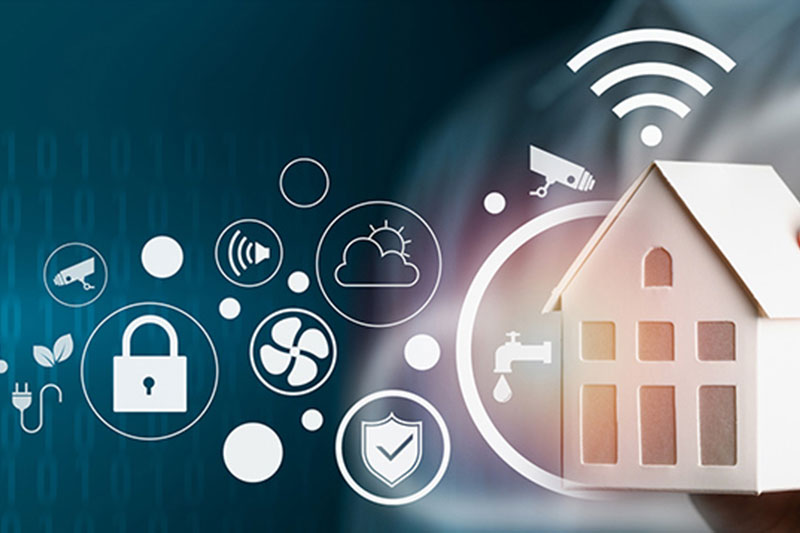
How IoT is Revolutionizing Smart Homes and Offices?
The Internet of Things (IoT) is no longer a futuristic concept—it’s reshaping how we live and work today. Smart homes and offices are leveraging IoT-driven automation, connectivity, and data intelligence to enhance convenience, efficiency, and security. As businesses seek competitive advantages and homeowners demand greater control over their environments, IoT is bridging the gap between technology and daily life.
For enterprises, this transformation presents opportunities to innovate, optimize operations, and deliver smarter solutions to consumers. Whether it’s real estate developers, office space designers, or tech companies, businesses that integrate IoT into their offerings will stay ahead in an increasingly digitized world.
How IoT is Transforming Smart Homes?
1. Connected Appliances and Home Automation
IoT-enabled smart homes operate seamlessly through connected devices that communicate in real time. Smart refrigerators track inventory and suggest shopping lists, while smart ovens adjust temperatures remotely. Washing machines, robotic vacuum cleaners, and voice-controlled entertainment systems streamline household management, offering homeowners unprecedented convenience.
Home automation extends to centralized control systems where smart assistants like Amazon Alexa, Google Assistant, or Apple HomeKit integrate multiple devices. Users can manage lighting, thermostats, and security systems through voice commands or mobile apps, enhancing accessibility and efficiency.
2. Smart Security Solutions
Safety remains a top priority in smart homes. IoT-powered security systems provide real-time monitoring, AI-driven facial recognition, and remote-controlled locks. Smart doorbells with video streaming allow homeowners to see and interact with visitors from anywhere in the world. Sensors detect unusual activity, sending instant alerts to homeowners and emergency services, preventing potential threats before they escalate.
3. Energy Efficiency and Sustainability
With rising energy costs and environmental concerns, IoT contributes to sustainable living. Smart thermostats, such as Nest and Ecobee, adjust temperatures based on occupancy, optimizing energy use and reducing bills. Smart lighting systems use motion sensors to turn lights on and off automatically, further conserving energy. Homeowners can track energy consumption through IoT dashboards, making informed decisions about energy efficiency.
4. Personalized Living Experiences
IoT-driven personalization enhances user experiences. Smart homes learn routines, adjusting settings to match lifestyle patterns. From pre-setting coffee machines in the morning to automatically dimming lights for bedtime, these systems create a tailored living environment that enhances comfort and productivity.
Impact of IoT in Smart Offices
1. Automated Workspaces for Efficiency
IoT is reshaping modern workspaces by optimizing resources and improving employee productivity. Smart offices utilize IoT sensors to monitor occupancy, automatically adjusting lighting and climate control to create a comfortable work environment while reducing operational costs. Desks and meeting rooms are booked via IoT-powered scheduling systems, streamlining space utilization.
2. Enhanced Security and Access Control
Security in offices has evolved with IoT integration. Biometric access, RFID-enabled entry systems, and AI-driven surveillance offer comprehensive security solutions. Smart office systems detect unauthorized access attempts and alert security teams instantly. Additionally, businesses can monitor employees’ access logs, enhancing accountability and compliance with security policies.
3. Remote Monitoring and Smart Facility Management
IoT enables facility managers to oversee multiple office locations remotely. Real-time data on air quality, lighting conditions, and system performance allow for predictive maintenance, reducing downtime and operational costs. IoT sensors track equipment usage, ensuring timely servicing and preventing malfunctions before they disrupt business operations.
4. AI-Powered Workplace Productivity
AI-integrated IoT solutions help optimize workflow by automating repetitive tasks. Smart assistants schedule meetings, control conference room settings, and even provide real-time transcription services. AI-driven analytics offer insights into workplace productivity, helping organizations improve efficiency and employee satisfaction.
Business Benefits of IoT Adoption
For enterprises, integrating IoT into smart homes and offices is more than just a trend—it’s a strategic move with long-term benefits:
- Cost Savings: IoT reduces energy consumption and automates routine tasks, cutting operational expenses significantly over time.
- Data-Driven Insights: Businesses can collect valuable data on consumer behavior, optimizing service delivery and personalization for greater customer satisfaction.
- Enhanced Security: Real-time monitoring and AI-driven surveillance ensure safer environments for both employees and consumers.
- Competitive Advantage: Companies offering IoT solutions position themselves as leaders in innovation and smart technology, giving them a significant edge in the market.
Challenges and Considerations
Despite its advantages, IoT adoption comes with challenges that businesses must address:
- Cybersecurity Risks: With multiple connected devices, data breaches and hacking threats increase. Implementing strong encryption and security protocols is essential.
- Device Compatibility: Standardizing IoT devices ensures seamless integration across platforms.
- Initial Investment Costs: While IoT implementation requires significant investment, the long-term savings and efficiency gains outweigh the costs.
The Future of IoT in Smart Living
The IoT landscape continues to evolve, with several key developments shaping the future:
- 5G Connectivity: Faster and more reliable networks will enhance IoT capabilities, improving real-time communication between devices.
- AI and Machine Learning Integration: IoT devices will become smarter, predicting user needs and automating tasks more effectively.
- Sustainable Smart Living: Businesses will focus on developing eco-friendly IoT solutions, aligning with global sustainability goals.
Embrace A Connected Future
IoT is revolutionizing the way we interact with our surroundings, from homes that anticipate our needs to offices that enhance efficiency. As businesses and consumers embrace this technology, the opportunities for growth and innovation are endless. The future of smart living is not just about convenience, it’s about creating intelligent, sustainable, and secure environments that redefine the way we live and work.
For organizations, now is the time to invest in IoT-driven solutions. Whether developing smart devices, integrating automation, or providing IoT consultancy, the businesses that innovate today will lead the smart revolution of tomorrow.
To explore the latest advancements in smart living solutions, attend Smart Living Expo 2025 from September 17-19, 2025, at IMPACT Exhibition Centre, Bangkok, Thailand. Connect with industry leaders, discover unique IoT solutions, and be a part of the future of smart living.


